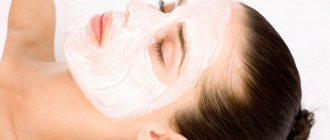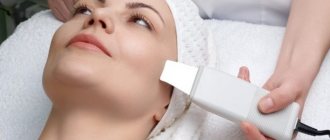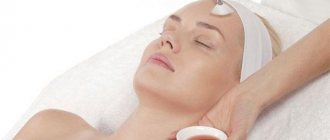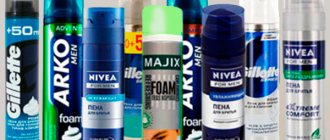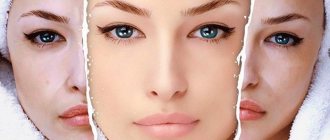Ultrasonic skin cleansing is a type of hardware peeling. It cleanses pores and helps with non-inflammatory acne, improves skin condition without damaging the skin. As a result of such cleansing, blood circulation improves, acne disappears, and fine wrinkles are smoothed out. This is the most gentle method of cleansing the skin, which is prohibited during pregnancy, but is acceptable in the first half and during lactation.
Let us immediately note that due to hormonal changes after childbirth and during breastfeeding, the results after the procedure can be unpredictable. According to reviews, many mothers do not see any improvement or changes. Therefore, such a procedure is often meaningless. In addition, ultrasonic cleansing itself is only suitable for minor defects and non-inflamed skin.
To achieve maximum results, it is often necessary to use complex procedures, many of which are prohibited during lactation. As for ultrasound, this is a fairly harmless procedure. Let's take a closer look at how it's done. And we’ll find out whether it’s possible to do ultrasonic facial cleansing while breastfeeding.
Specifics, pros and cons of the procedure
Ultrasonic cleansing removes blackheads, blackheads and dead cells from the surface of the skin. In this case, skin cleansing is performed using ultrasonic high-frequency waves. The waves penetrate deep into the skin tissue and produce micromassage. This type of cleansing is suitable for the face, neck, back and décolleté.
Ultrasound has a gentle and gentle effect on the skin and is painless, but with some discomfort. The big advantage of this procedure is that it does not squeeze, stretch or damage the skin. It does not provoke injuries, bruises and wounds, redness and irritation, like some types of mechanical cleaning. And it does not require special preparation of the skin.
Ultrasonic cleaning resembles superficial peeling and performs the following functions:
- Stimulates blood circulation, metabolism and material metabolism;
- Normalizes the functioning of the sebaceous glands;
- Warms tissues and makes them elastic;
- Makes skin clean and well-groomed;
- Cleans and, if necessary, tightens pores;
- Accelerates the healing of wounds and scars;
- Increases tone and reduces oily skin;
- Eliminates swelling and dark circles under the eyes;
- Lightens age spots, removes pimples and blackheads;
- Renews and restores cells.
This technique does not remove deep sebaceous plugs, inflamed pimples and increased rashes. It does not have a rejuvenating effect. And to maintain the effect, the procedure will have to be repeated every month. For long-term effects and more complex cases, it is recommended to carry out mechanical cleaning or a complex of various measures to clean the skin.
Cosmetologist's advice
If everything is clear with the ban on the injection of hyaluronic acid, is it possible to use external products based on it - a variety of creams, masks, tonics, etc.?
In fact, there are no strict contraindications for such use - absorption into the blood from the surface of the skin is very weak, so it does not pose a threat to the body of a pregnant woman or her unborn baby. In addition, if any undesirable reaction occurs, such as an allergy or dermatitis, it can be easily eliminated by simply discontinuing this drug. However, it is important to understand that during a period of such powerful hormonal changes in the body, you can become allergic to hyaluronic acid and drugs based on it. After this, even 10 years after pregnancy, it will be impossible to do anti-aging procedures using this compound without risk.
During this delicate period, it is better to disturb your body and skin as little as possible - even apply decorative cosmetics less. The less you load yourself with cosmetics now, the faster you can restore your beauty after the birth of your child. And both cosmetologists and doctors of other specialties are unanimous in this opinion.
All articles on the topic: Mesotherapy
Indications and contraindications
Ultrasound cleaning is recommended for aging and sagging skin, decreased tone and enlarged pores. It is useful for oily skin, in the presence of pimples, blackheads and blackheads, but not during periods of inflammation and exacerbation.
This procedure does not affect breastfeeding in any way, so it is allowed for nursing mothers. It does not cause an allergic reaction and takes about half an hour. Cleaning can be carried out at any time of the year, and to maintain the effect, it is advisable to repeat it at least once a month. To obtain the maximum effect, you need to perform five to eight sessions.
When choosing this procedure, keep in mind that it will not help with severely clogged pores, acne and skin inflammation. Despite the safety and popularity of such cleaning, nursing mothers note the low effectiveness of ultrasound during breastfeeding due to hormonal changes.
Ultrasonic cleaning is prohibited during pregnancy, severe hypertension and cancer, asthma and epilepsy. The procedure cannot be done for neuralgia, herpes and infectious diseases, eczema and dilated blood vessels.
Despite the fact that ultrasonic facial cleansing is permitted while breastfeeding, in any case, first consult with your doctor. Be sure to warn the cosmetologist who performs the cleaning that you are currently breastfeeding. Trust the procedure only to experienced and trusted specialists. Under no circumstances should you carry out such cleanings at home!
What will cosmetologists say?
The advice of cosmetologists on peelings during breastfeeding is as follows:
- It is strictly not recommended to do acid peeling on your own;
- It should be taken into account that the peak of hormonal changes occurs 3-6 months after birth. As he approaches the age of one year, he approaches the prenatal indicator;
- before using any composition (including alternative means), it is necessary to do a tolerance test;
- strictly follow the post-departure rules recommended by a specialist;
- be prepared for the possibility of unpredictable consequences - pigmentation, the appearance of mycoses, exacerbation of herpes. If the procedure is performed by an experienced cosmetologist, he can foresee such complications. Conclusion - we trust only professionals.
And most importantly, there is no need to delay solving problems that have arisen and putting off solving them until after feeding. After all, there are cases when correcting the situation “later” will be very difficult, and sometimes almost impossible.
Facial care after ultrasonic cleaning
- After the session, for the first 12 hours you cannot wear make-up, apply any decorative cosmetics, dye your hair or eyebrows;
- To prevent drying and inflammation of the skin and clogging of pores, carefully monitor the condition of the skin for three days. If necessary, consult a cosmetologist;
- If ultrasound causes dry skin, use a moisturizer regularly;
- Before going outside, apply sunscreen with an SPF factor of 20 or more;
- Once a week, make masks that restore the epidermis. Compositions made from cosmetic clay, sea buckthorn oil, yeast and algae are well suited;
- To soothe the skin, wipe it with ice from a decoction of calendula, chamomile or sage;
- After the procedure, you cannot go to the solarium, bathhouse or sauna for 24 hours.
Natural methods to fight acne
For nursing mothers, folk methods rather than salon procedures will be much healthier and safer. The main thing is that the components do not cause an allergic reaction. Of course, you will not achieve a lightning-fast and stunning effect. But with regular use of the products, you will achieve visible results and improve the condition of your skin.
For home peeling, mix a tablespoon of sour cream and granulated sugar until the mixture is smooth. Cleanse your face with milk or other suitable product. Steam the skin and apply the prepared mixture, avoiding the area around the eyes. Massage your face and leave the product on for ten minutes. Then rinse with warm water or a herbal decoction. Finally, lubricate your skin with moisturizer.
Pay attention to nutrition and lifestyle. Reduce the amount of fatty and junk food. Introduce more fresh vegetables and fruits into your diet, eat boiled, baked or stewed meat and fish. Avoid fried foods, soda and strong coffee, products containing preservatives and flavorings.
In addition, this diet is optimal for nursing mothers. It will not cause food allergies, severe colic, flatulence and other problems in the baby. Read more about nutrition rules when breastfeeding.
Physical activity and exercise promotes good blood circulation and ensures proper breathing of the skin, strengthens the immune system and has a beneficial effect on the body. Even simple walks in the park are suitable for a nursing mother. In addition, you can use joint fitness or swimming with your baby. Read about what types of sports and physical activity you can do while breastfeeding in the article “Sports after childbirth.”
Be sure to maintain good hygiene and wash your face regularly. You can make homemade masks or use ready-made scrubs. Of course, with a baby it is difficult to find time for yourself. But if you want to maintain beauty and health, this must be done.
Homemade acne masks
Lemon and egg peeling mask
Beat one egg white, add lemon juice and mix. Apply the resulting composition to the skin in three to four layers, each layer is applied with an interval of five to seven minutes. Leave the mask for twenty minutes after applying the last layer. Then wash off with cool water. Be careful, this mask is not suitable if you or your baby are allergic to citrus fruits or protein.
Cucumber mask
A cucumber mask is already suitable for every skin type, and an allergic reaction to such a vegetable is extremely rare. Fresh cucumber needs to be peeled and chopped in a blender. Pour the mixture with two glasses of boiling water and leave for 15 minutes. For oily skin, add a teaspoon of baking soda. Apply to face for 10-20 minutes and then rinse with warm water.
Clay and carrot masks are also suitable for fighting acne and restoring the skin. In any case, neither you nor the baby should be allergic to any component. Unfortunately, many nursing mothers face not only skin problems, but also hair problems. Curls thin and fall out, becoming dull and lifeless. Homemade masks will also help here, recipes for which you will find at the link https://vskormi.ru/mama/pri-grudnom-vskarmlivanii-vipadayt-volosi-chto-delat/.
Is it possible to do peeling while breastfeeding?
Peeling is more or less intense damage to the upper and middle layers of the skin in order to stimulate epidermal renewal processes, eliminate surface defects and pathologies. There is a clear list of contraindications to chemical peeling. And it includes pregnancy and lactation period.
But whether peeling is acceptable during lactation is a controversial question. The answer is determined by the chemical composition used:
- Deep and medium peeling is strictly prohibited during breastfeeding. The drugs are based on aggressive chemicals. They penetrate deep into the skin tissue, from there into the bloodstream, spread throughout the mother’s body, and end up in breast milk. If the concentration of chemical compounds is harmless to the body of a nursing woman, then the baby, having dined on poisoned milk, can become seriously intoxicated.
- Superficial peeling is a gentle option for facial cleansing. Mild reagents are used, the concentration of which in the composition does not exceed 10%. Only the superficial layers of the skin are exposed; chemicals do not penetrate the bloodstream. Therefore, there is no harm to the baby. But cosmetologists warn about a possible negative reaction of the female body, experiencing a hormonal storm, to exposure to irritating substances.
Summary
To summarize: chemical peeling during lactation is not as harmful as it might seem at first glance. BUT... Only if the procedure is performed by an experienced cosmetologist, taking into account all individual characteristics.
Important! Be sure to tell your doctor that you are breastfeeding. It would not be amiss to mention how much time has passed since the birth. And feel free to answer questions, even if they seem a little inappropriate. Believe me, this is not idle curiosity, but a professional approach.
Incredible! Find out who is the most beautiful woman on the planet in 2020!
Women tend to want to look good, and nursing mothers are no exception to this rule. During the postpartum period, it is especially important to feel beautiful and attractive again. Facial and body care helps restore peace of mind, gain self-confidence and get rid of postpartum depression.
But before you pay a visit to a cosmetologist, you need to figure out which procedures will benefit the nursing mother’s body, and what should be avoided so as not to harm the baby and not face negative consequences regarding your own appearance. The list of actively discussed procedures includes chemical peeling. Is it acceptable for breastfeeding?
Chemical peeling is a procedure during which the surface layers of the skin epithelium are removed with special means based on acids of varying concentrations.
Accordingly, under the influence of these agents, the skin receives a chemical burn. Its depth depends on various factors, including the type and concentration of the acid, the duration of contact of the product with the epidermis, the individual sensitivity of the skin, etc.
The procedure is aimed at destroying the top layer of skin cells and stimulating the regeneration process. As a result, the skin is rejuvenated, unevenness and fine wrinkles are smoothed out. The face takes on a fresh and radiant appearance.
Harm to nursing mothers
Chemical peeling is harmful during breastfeeding not only for the baby, but also for the nursing mother. If a baby can only suffer from deep exposure, then women’s skin can react negatively to a superficial procedure. The problem is associated with a serious transformation of a woman’s hormonal background during pregnancy and after childbirth.
Expert opinion Anastasia Zaslavskaya Dermatologist, cosmetologist Cosmetologists, playing it safe, do not advise breastfeeding patients even superficial peeling, since they cannot predict the reaction of the body, in which hormones are raging, to acid exposure.
When the skin comes into contact with acids, age spots and other unpleasant formations may appear, which are difficult to remove. Certain chemicals help get rid of excess pigmentation, but they cannot be used during the lactation period due to possible harm to the baby. Unfortunately, a woman has to walk around with ugly skin until the end of the breastfeeding period.
Why can’t a chemical procedure be done during lactation?
Peeling is damage to the skin by chemical, thermal or mechanical action in order to eliminate dead cells, fine wrinkles and age spots.
During breastfeeding, thermal or chemical peeling is strictly prohibited.
Deep peels using chemicals or lasers should not be done for the following reasons :
- After childbirth, the female body is exhausted, the process of restoring muscles and organs to prenatal parameters is underway, and a lot of effort is also spent on producing breast milk. After this traumatic type of peeling, the body will have to restore deeply damaged skin, so the load will increase.
- After peeling, decay products of dead tissue and substances used during the procedure will penetrate into the blood and then into breast milk, which can harm the baby.
- A skin burn from peeling is stress for the body, as a result of which the quantity and quality of milk can significantly decrease.
Reference . During breastfeeding, it is better to scrub your facial skin with a special washcloth that does not require the use of cosmetics.
Hormonal changes
During lactation, as during pregnancy, a woman’s hormonal background is greatly changed. The skin reacts to hormone surges with dryness or vice versa – oiliness , allergic reactions, even to familiar cosmetics:
- rashes;
- the appearance of age spots;
- as well as decreased immunity.
We recommend: What is the difference between retinol and retinoic peels? Which procedure should I choose?
Damage to the skin by peeling during this period may lead to the development:
- bacterial complications in the form of erysipelas or streptoderma;
- fungus - favus, trichophytosis;
- herpes.
These complications will have to be treated with serious medications, and it is possible that breastfeeding will be prohibited during this period.
The appearance of age spots
Women's skin, during lactation, is very photosensitive and prone to the appearance of age spots, even if exposure to sunlight is short-term.
Peeling will only increase the skin's sensitivity to the sun and pigmentation will most likely not be avoided.
Removing stains will be difficult and quite expensive, so it is better to do deep peeling only after breastfeeding , and if you really want to refresh your face, then use products based on fruit or lactic acids with a very low concentration of the active substance - less than 10%.
Harm to the child
In the first months of life, the baby’s body is not protected and is quite weak, so breast milk is the only source of nutrients and antibodies to various infections. If a dangerous substance enters the child’s body through breast milk, he may become ill or begin to develop worse.
Deep peels contain precisely those dangerous substances that clearly penetrate into the bloodstream and breast milk, so manufacturers and cosmetologists are against applying them to the skin of a nursing woman.
Important! The use of superficial peeling is allowed, but most of them contain retinoic and salicylic acids, which also enter the blood and milk, creating mild intoxication, which the mother’s body with a mature liver will not particularly notice, but this is not useful for the child. Therefore, from superficial peels you need to choose only completely safe ones.
Safe alternative to chemical peels
Nursing mothers can choose more gentle salon procedures, or use folk recipes for facial cleansing. In the salon, a breastfeeding woman can be offered:
- Ultrasonic cleaning, soft, harmless, painless. Ultrasound affects only the superficial layer of the skin, removes dead skin cells, comedones, and normalizes metabolism in tissues.
- Mechanical cleaning, effective, but quite painful. The skin is treated with fingers or special instruments; no chemicals are used.
- Glycolic peeling. Ideal for oily skin, enlarged pores, and multiple comedones. Glycolic acid not only perfectly cleanses, but also smoothes out skin unevenness.
- Dairy is the safest. Human skin tissue contains its own lactic acid. That is, the substance is native to skin cells and does not cause an allergic reaction.
- Almond peeling. The active ingredient is mandelic acid, which has an antioxidant and antimicrobial effect. The result of the procedure is the elimination of rashes, strengthening of local immunity, increasing the firmness and elasticity of skin tissue.
- Pyruvic acid peeling is an excellent option for acne and ulcers. Women who have given birth often experience skin rashes due to hormonal changes. And pyruvic acid can easily cope with this problem.
At home you can use the following recipes:
- Vegetable peeling. Vegetables and herbs that contain a lot of acids are taken: tomatoes, sorrel, celery. Grind in a blender, apply to a clean face, hold for 5 minutes, rinse with warm water. After the procedure, the face is treated with the usual cream.
- Fruit. It is made according to the vegetable principle, only sour berries and fruits are used: currants, kiwi, citruses.
- Coffee. Kefir is mixed with coffee grounds. The resulting scrub is rubbed into the skin with light massaging movements and washed off with warm water. Next, use a moisturizer.
- Sugar. Sugar and sour cream are combined in equal proportions. The scrub is rubbed into the skin with soft massaging movements and washed off with warm water. Sour cream whitens, evens out tone, and grains of sugar remove dead skin cells.
When visiting a beauty salon, be sure to notify the specialist about your status as a nursing mother. A specialist will select an effective and safe type of facial cleansing. Cosmetologists do not recommend going to them in the first six months after childbirth, since during this period hormonal changes are at their peak stage.
WHAT CHANGES IN A WOMAN’S BODY
As you know, the mother’s body works “both for itself and for that guy”: after all, the baby does not yet have its own immune system, and its existence is supported by the mother’s resources. Internal organs, bones, muscles and joints - everything works at full speed.
As a result, the skin can “deteriorate”: due to endocrine changes, pores become clogged, pustules and rashes appear, and the complexion becomes dull. A limited diet prescribed by a doctor also contributes: a woman simply does not have enough vitamins and minerals.
Against the background of these changes, even simple cosmetics can cause a violent skin reaction, not to mention “controlled stress” for the epidermis, as peelings are often called. After all, the very principle of this procedure is to destroy the upper layers of the skin to trigger natural tissue regeneration.
We recommend: PEELING OR MESOTHERAPY: which is better?
Facial cleansing during breastfeeding
There are several types of cleaning: using current, ultrasonic waves or vacuum. Simple mechanical cleaning is also distinguished separately. During pregnancy and breastfeeding, a woman’s body experiences enormous stress, therefore, in order not to add stress, it is recommended to refrain from visiting a cosmetologist. If the procedure is simply necessary, you need to consult a doctor, choose the optimal technique and be sure to warn the specialist in the salon about your situation. Facial cleansing techniques There are four ways to cleanse the facial skin of unwanted elements: Ultrasound peeling – local exposure to high-frequency ultrasound; vacuum – creating negative pressure between the skin and a special device; disincrustation – the procedure is carried out using electric current; mechanical cleaning using a spatula. Facial cleansing during breastfeeding is only possible if the client has previously undergone the same procedure more than once. Preference should be given to the least painful method, which has the least impact on the body - mechanical. However, not a single cosmetologist will guarantee the absence of consequences. Consequences of facial cleansing during breastfeeding Since during pregnancy and breastfeeding, a woman’s hormonal activity is constantly changing, it is impossible to predict how cleansing will affect the skin of the face. The appearance of scars, pigment spots, acne, accelerated occurrence of rashes, and blockage of sebaceous ducts is possible. An obstetrician-gynecologist and cosmetologist will help determine whether it is possible to do cleansing during lactation, but the best solution would be to refrain from the procedure. It will become completely safe only a few months after the end of feeding, when the hormonal levels return to normal.
Other procedures
A young mother can visit the sauna and bathhouse if there are no health problems. If there is any inflammation, it is better to abstain and wait another month after recovery. If milk stagnation or excessive secretion occurs, visiting the bathhouse is contraindicated.
Nail extensions are also not prohibited, although some mothers complain that their nails do not last as long as usual. You should also think about the length - nails that are too long can cause injury to your baby. And a beautiful manicure can be done on short nails, the main thing is that they are neatly shaped and look well-groomed.
You can also do hair removal - for example, with cream or wax. But there are contraindications for electro-, photo-, laser, and enzyme hair removal - these types of hair removal cannot be actively used during lactation. Laser hair removal during breastfeeding is also ineffective because high levels of hormones will trigger the growth of new hair, and the procedure will simply be done in vain.
Remember, there is an alternative to any procedure. Replace an unsuitable mask with another, acid peeling with a more gentle one. Prefer regular shaving to laser hair removal, and natural color to hair dye. The lactation period is not a reason to deny yourself the pleasure of being beautiful, but we should not forget that the baby’s health comes first.

